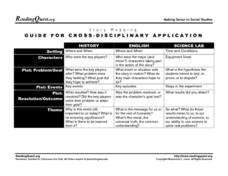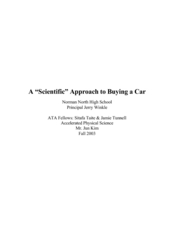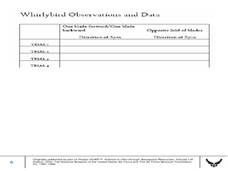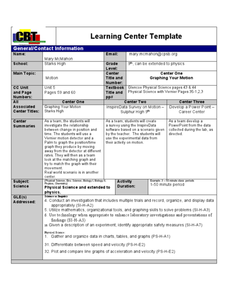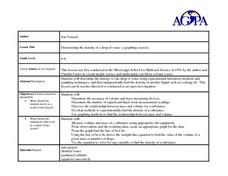Curated OER
Story Mapping: Guide for Cross-Disciplinary Application
In this story mapping worksheet, students read how story mapping can apply to 3 different areas of study: history, English and science lab. The components of story mapping that are included here are setting, characters, problem/goal,...
Curated OER
A “Scientific” Approach to Buying a Car
Students examine what it takes to purchase a car and the resources out there to help find what you are looking for. In this scientific method instructional activity students complete different problem solving situations.
Curated OER
Graphing Speed; Slope
In this graphing speed worksheet, students find the slope in a position vs. time graph to be the speed. They are given example graphs of position vs. time to show the changes in slope reflect the changes in speed. Students match terms...
Curated OER
Principles of Flight: Gyrocopter and the Scientific Method
Students explore the concept of the scientific method. In this investigative lesson, students investigate which direction the blades will spin on a gyrocopter. Student will practice using the scientific method to complete the investigation.
Curated OER
Endothermic and Exothermic Lab
In this endothermic and exothermic reactions worksheet, students experiment with water and a salt of choice to determine if heat is absorbed or released in the reaction. Students take the temperature of their solution over a 2 minute...
Curated OER
Me And My Shadow
Students investigate the concept of a shadow. They design a tool to create shadows for an experiment. They make observations and record the size and shape of shadows. The lesson contains background information for the teacher to deliver...
Curated OER
How Much Energy is Stored in Wood?
For this energy lesson, students create calorimeters out of soda cans and use them to calculate the amount of energy stored in different types of wood.
Curated OER
Making a Line Graph
In this line graph worksheet, students use data given in a table and assign axes, make a scale, plot data and make a line or curve on their constructed graphs.
Curated OER
Using the Scientific Method
In this scientific method activity, students click on the links in the questions about the scientific method to find the answers to the questions and then come back and answer the questions. Students answer 12 questions total.
Curated OER
Ziplock Chemistry
Students investigate various chemical reactions when creating mixtures in ziplock baggies. In this chemistry lesson, students will recognize various chemical reactions and cite evidence. Safety and assessment strategies are included in...
Curated OER
Force & Acceleration
Students investigate the effects of weights on the motion of a toy car. In this force and acceleration lesson plan, students use different weights, a toy car, a paper clip and string to determine how a car will move as different weights...
Curated OER
Which Brand of Air Freshener is Most Cost Effective?
Students use scientific method to determine cost-effectiveness of air freshener, and create PowerPoint presentations to share their results.
Curated OER
Olympic Line Graphs
Sixth graders examine how to make line graphs. In this Olympic line graph lesson students make line graphs and search the given Internet sites to find data on their summer Olympic Game.
Curated OER
Scientific Problem Solving
In this problem solving worksheet, learners will put the 7 steps to problem solving in a logical order. Then students will design a hypothetical study comparing a person's weight on Earth with his weight on Mars and complete 3 short...
Curated OER
Collecting and Analyzing Data
In this collecting and analyzing data worksheet, students collect data from an experimental investigation about the relationship between the color of a Tootsie Roll Pop and the time it takes to get to the chocolate center. ...
Curated OER
Pendulum Problems
Ninth graders explore how pendulums function. In this pendulums lesson students complete a pendulum lab activity.
Teach Engineering
Combustion and Air Quality: Emissions Monitoring
Help your class determine the types of pollutants coming from vehicle exhaust. Groups use an air quality monitor to determine the emissions from different vehicles, to gain knowledge about combustion energy, and to predict how the...
Curated OER
Volume of Gas
Eighth graders investigate the effect of temperature on the volume of a gas in a closed container. They measure the height of the water in their beaker/container, conduct their experiment, and create a graph to illustrate their data.
Curated OER
Modeling Hot and Cold Planets
Students, in teams, design and construct models of two planets, one hot and the other cold, using a variety of materials. They attempt to create the models out of substances that will actually show the greatest temperature differences...
Curated OER
Rate of Photosynthesis
High schoolers investigate the rate of photosynthesis using elodea leaves. In this photosynthesis lesson plan, students place elodea in a test tube filled with water. They include baking soda and place the test tube under a lamp. High...
Curated OER
Graphing Linear Motion
In this graphing linear motion worksheet, learners answer 20 questions about velocity of objects, the distance they travel and the time. They interpret a graph of position vs. time and identify the velocity at certain point on the graph.
Curated OER
Gravitational Acceleration
Students investigate the interdependence of mass and gravitational acceleration using computer simulation. In this physics lesson, students derive the formula for acceleration due to gravity. They calculate air resistance on falling...
Curated OER
"Graphing Your Motion"
Students study the concepts of motion, velocity, and acceleration through graphing their own movement using LoggerPro. They explain the difference between speed and velocity using the weather vane example. They discover the difference...
Curated OER
Determining the Density of a Drop of Water-A Graphing Exercise
Students determine the density of 1 drop of water. In this determining density lesson plan, students determine the mass and volume of a drop of water in the lab using appropriate lab techniques and calculate the density of a drop of water.


